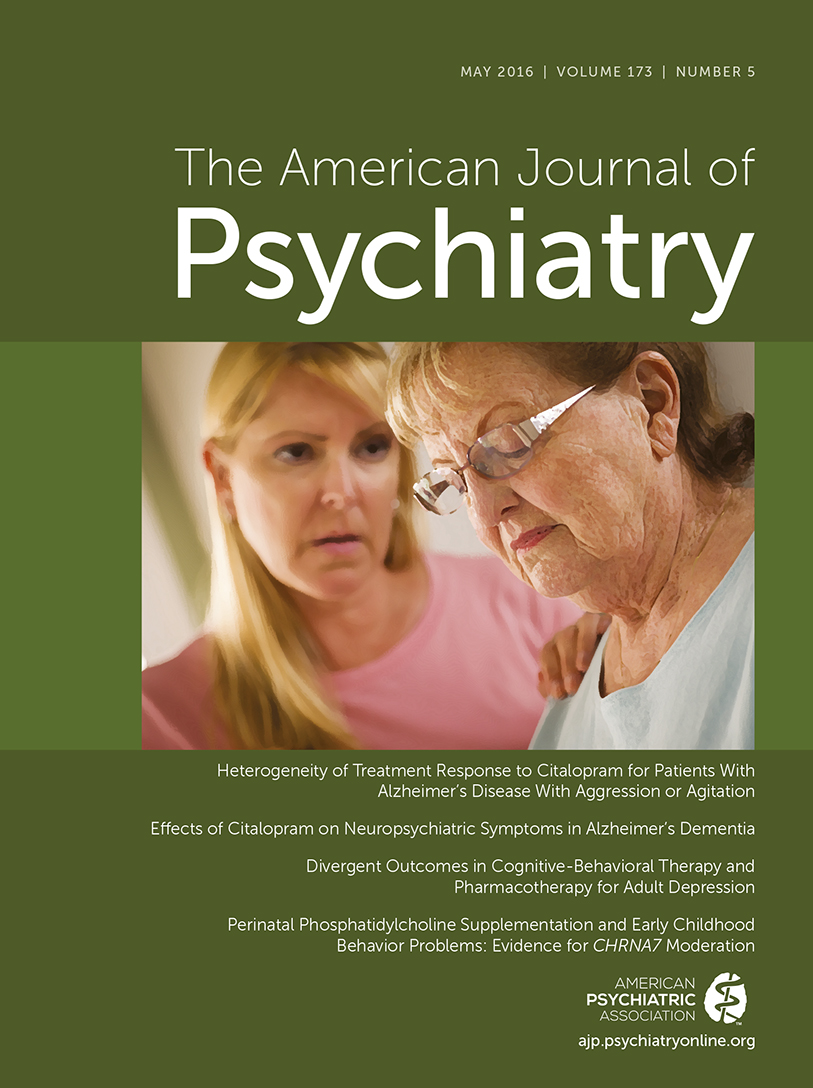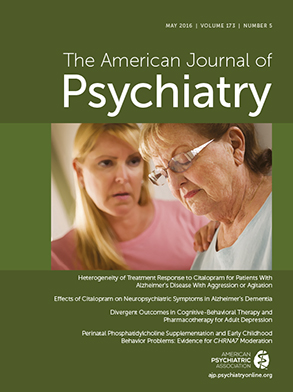T
o the E
ditor: Theories relating the etiology of schizophrenia to immune response date back more than a century (
1). Therefore, the recent [
11C]PBR28 positron emission tomography (PET) study by Bloomfield et al. (
2), published in the January 2016 issue of the
Journal, is an important one with implications for early diagnosis and therapeutic strategies. However, we outline concerns with respect to the outcome measures and analyses used in this study to arrive at the conclusion that microglial activation is elevated in patients with schizophrenia and in persons at ultra high risk for psychosis.
Determining the primary outcome measure to be used in any PET study is critical and has been the topic of considerable effort to ensure consistency in the field (
3). Traditionally, for PET radiotracers that lack a true reference region, the regional distribution volume (V
T) is used as the outcome measure; in the present study, the failure to find any significant between-group differences with this measure is a concern (see Table S5 in the data supplement that accompanies the online version of the original article). The authors used an alternative outcome measure, distribution volume ratio, as their primary outcome measure in this study. The distribution volume ratio was arrived at by normalizing a region of interest V
T to total brain V
T. This approach is problematic because [
11C]PBR28 binding in the region of interest is represented in both the numerator and the denominator. In addition, total brain V
T is vulnerable to differences in white and gray matter ratios, cortical and subcortical region volumes, etc., making this measure undesirable to use for normalization. The authors evaluated the bias of total brain V
T normalization by comparing it with normalization in two regions with low translocator-protein (TSPO) activity (the cerebellum and white matter). Unfortunately, these region-based approaches do not clarify whether the higher distribution volume ratio values in schizophrenia subjects and in ultra-high-risk subjects are a result of greater microglial activation in the region of interest or of lesser microglial activation in the cerebellum (or white matter). In fact, data in Table S2 (in the data supplement that accompanies the online version of the original article) shows cerebellum V
T at a trend level lower in schizophrenia subjects compared with control subjects, thereby supporting the latter possibility. We acknowledge the fact that recent [
11C]PBR28 studies have advocated the use of simplified outcome measures, such as distribution volume ratio and standardized uptake value, to reduce within-group variability in clinical studies. Nevertheless, prior to use, it is critical to demonstrate concurrence between distribution volume ratio and V
T and to ensure that the disease does not affect binding in the region used for normalization, as shown for the cerebellum in Alzheimer’s disease (
4). Unfortunately, the findings reported with distribution volume ratio in this article fail to meet this rigorous standard.
There are additional statistical concerns in this data set. For example, in Table S6 and Figure S3 in the online data supplement (data for control subjects and for ultra-high-risk subjects were partitioned by genotype), there are large standard deviations and no apparent difference in the means; in the first grouping in Figure S3, the estimated standard deviation is approximately 0.5. However, in the table, the standard deviation is listed as 0.016. Assuming that this standard deviation is a modified one arrived at by covarying for age, this represents a 97% reduction in standard deviation. This would suggest that all the variance in the [11C]PBR28 distribution volume ratio data is explained by age. To our knowledge, such a large effect for age is not evident in any published [11C]PBR28 data set. Congruent with this line of thinking is the authors’ own modest r statistic of 0.31 for the distribution volume ratio versus age in Table S3. The r statistic would have to be much higher in these data for nearly all the variance in the distribution volume ratio to be explainable by age.
In summary, it may have been beneficial to the field to see these data published as a negative study utilizing the standard outcome measure of V
T with a discussion of the distribution volume ratio findings as a secondary analysis. Interestingly, such a result would have been consistent with the only other study in schizophrenia that used a second-generation TSPO radioligand (
5).

